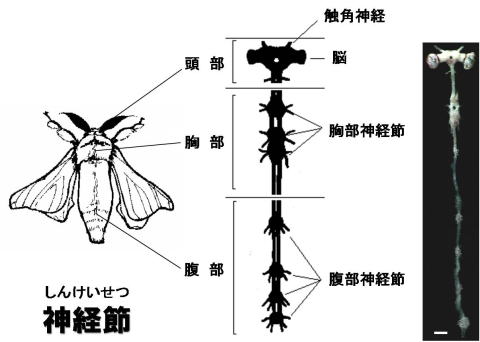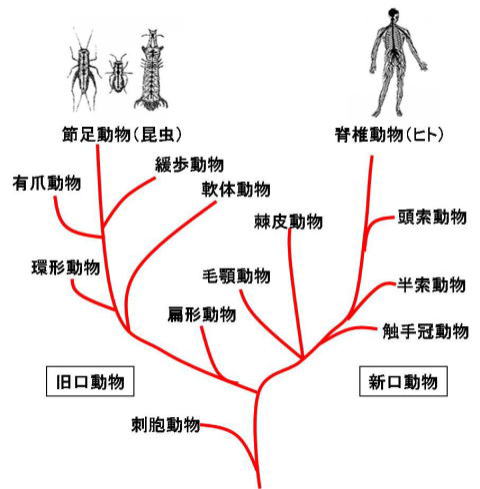Insect nervous system
The body of insects in divided into head (caput), thorax, and abdomen,
from anterior to posterior. These body segments are actually fused from
a larger number of ancestal segments. In the head alone, the supraoesophageal
ganglion (brain) and the suboesophageal ganglion (fused in Lepidoptera
as the silkmoth) actually represent 6 ancestral body segments. The remaining
ganglia are often called ventral nerve cord. In the thorax, three ancestral
thoracic ganglia have become more or less fused in different insect orders.
In the silkmoth, the thoracic ganglia form a nearly fused structure. This
basic trend towards fusion is also seen in the abdominal ganglia. The basic
segmentation pattern can be guessed from the fact that the abdominal segments
are generally externally visible. In the antero-posterior axis, the ganglia
are linked by connectives, one on each side of the body. Within the ganglia,
bilateral connections are present in the form of well defined fiber bundles:
the commissures. Each ganglion first of all forms a local sensory and motor
processing centre but can come under control of other ganglia, in particular
the brain in which higher functions such as the integration of information
from the ganglia, working memory, orientation learning etc. are localised.
But the brain also receives a great amount of direct sensory input: for
most insects, the eyes and the antennae are vital sensory instruments.
In particular, the antennae with olfactory, thermo-, hygro-, and mechanosensory
sensory organs (sensilla) are like hands for most insects (some insects
are essentially hand-less, like dragonflies and flies).The output of the
brain to the ventral nerve cord can control the overall behaviour of the
animal, if required.

Figure 1. Central nervous system of a silkmoth.
back
The ventral nerve cord is capable of a great deal of autonomous behavioural pattern generation that is used during walking and flight. However, without the coordinating action of the brain, complete behavioural patterns are generally not observed. Still, even when isolating the thorax by cutting of the head and the abdomen, rudimentary walking and wing flapping are possible. Almost 50 years ago, Horridge demonstrated that such simple preparations are also capable of operant learning. While leg posture generally adapts to the substrate, a different leg posture is learned by decapitated cockroaches and locusts when applying an electric shock as soon as the leg sags below a chosen angle. The preparations learn to maintain a leg posture that adjusts the leg to just above the angle at which punishment occurs. Hoyle and collaborators have shown that learning can essentially be reduced to single motor neurons whose properties can be altered by conditioning.

Figure 2. Evolution: insects and mammals belong to different branches of the animal kingdom, thus the brains also took different paths in evolution.
back
The insect body is divided into 3 parts formed by fusion of body segments: the head, the thorax, and the abdomen. Correspondingly, the nervous system is divided into the brain and suboesophageal ganglion (head), the thoracic ganglia (thorax) and the abdominal ganglia (abdomen, see Figure 1). The division into local decentralised processing in the ganglia and the connection between these local centers is a key feature of the insect nervous system. The connections are bilaterally symetrical and called connectives. Connections between the two sides inside the ganglia are called commissures. Local sensory and motor processing takes place in the ganglia while the brain acts as a higher control structure with integrative functions. The brain is also important for sensory processing, in particular of olfactory and visual stimuli. Even with the head (i.e. the brain) removed, basic functions such as walking and wing flapping are preserved but coordinated and directed behaviour is not. Surprising, some forms of learning occur at the level of the ganglia. This has been demonstrated by Horridge who showed that headless locusts and cockroaches can learn within half an hour to control their leg posture in order to avoid electric shocks.
back